Facial Recognition Market Size
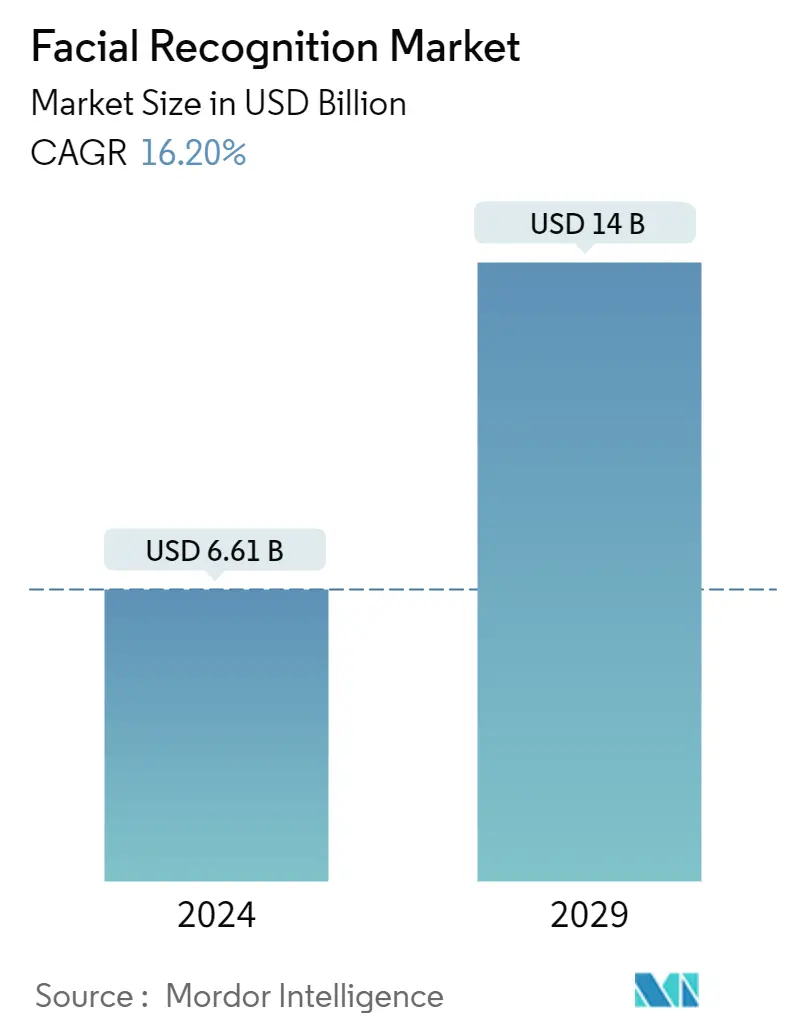
| Study Period | 2019 - 2029 |
| Market Size (2024) | USD 6.61 Billion |
| Market Size (2029) | USD 14 Billion |
| CAGR (2024 - 2029) | 16.20 % |
| Fastest Growing Market | Asia Pacific |
| Largest Market | North America |
Major Players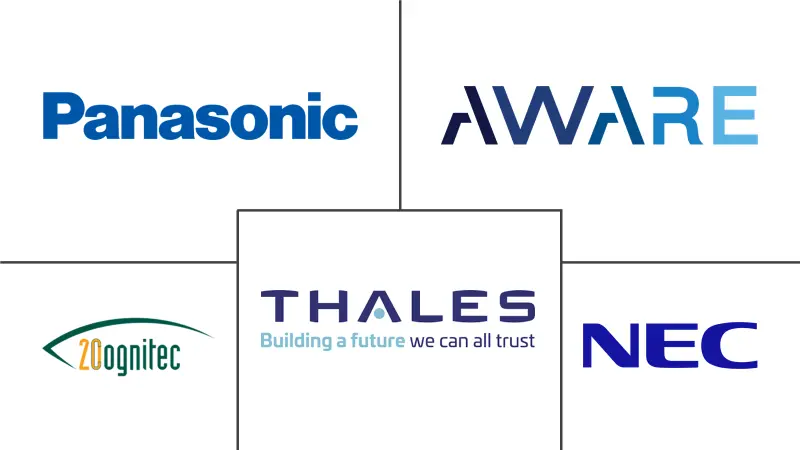
*Disclaimer: Major Players sorted in no particular order |
Facial Recognition Market Analysis
The Facial Recognition Market size is estimated at USD 6.61 billion in 2024, and is expected to reach USD 14 billion by 2029, growing at a CAGR of 16.20% during the forecast period (2024-2029).
Facial recognition refers to the way of identifying or confirming an individual's identity using their face. Facial recognition systems can be utilized to identify people in photos, videos, or in real time.
- Rising criminal activities worldwide have resulted in the increasing installation of surveillance systems across all verticals. For instance, according to the Council on Criminal Justice, thefts and robberies in major cities across the United States increased by around 20% in the first half of 2022. Integrating facial recognition in security systems can significantly enhance the effectiveness of security and surveillance across sectors and reduce overall costs.
- The market is witnessing various developments from private and public organizations, further boosting market growth. For instance, in August 2022, DRDO (Defence Research and Development Organization) developed an advanced Facial Recognition Technology (FRT) to increase surveillance. The DRDO has developed FRSD to solve the issue of facial recognition in the wild, where there are wide-ranging issues like low-resolution cameras.
- Government initiatives are expected to contribute to the significant growth of such technologies. For instance, As of July 2022, the CBP had deployed facial recognition technology to 32 airports for travelers leaving the U.S. and all airports for travelers entering the country.
- With the outbreak of the pandemic, facial recognition systems were adopted for wider use as they were used to track COVID-positive people who needed to stay home. Moreover, since the outbreak of COVID-19, facial recognition software vendors have upgraded their algorithms with new features, such as recognizing faces with a mask on.
- However, data breaches involving facial recognition data increase the potential for identity theft, stalking, and harassment as, unlike passwords and credit card information, faces cannot easily be changed. Such factors may hinder the market growth.
Facial Recognition Market Trends
Retail and E-commerce is Expected to Hold Significant Share
- While facial recognition technology did not initially absorb a massive demand from the retail industry, it provided adequate potential for the technology over the past few years. The advancement in three technical fields, neural networks, big data, and graphical processing units (GPU), has played a significant role in the widespread use of facial recognition technology in the sector. For instance, apparel retailers leverage technology to deliver customized products to customers visiting their stores.
- Facial recognition technology is expected to help retailers analyze mood and facial expressions at different SKUs and further enhance their shopping experience, preventing theft and shoplifting, as the technology helps increase security at the store level.
- The demand for cameras equipped with facial recognition technology among the stores is expected to surge over the forecast period. In addition to security and surveillance, the demand for technology in the industry is fueled by the growing application of enhancing consumer insights to offer a better customer experience.
- Facial recognition also allows retailers to personalize the shopping experience for customers. For instance, the technology could be used to identify a customer as they enter the store and then display personalized recommendations or offers on digital displays throughout the store.
- Moreover, receiving updates about the actual demographics of customers visiting the store at any given point can be a major challenge for any retail store management. Implementing facial recognition technology can help store authorities access the demographics of the footfall entering the store hourly and create business decisions based on that.
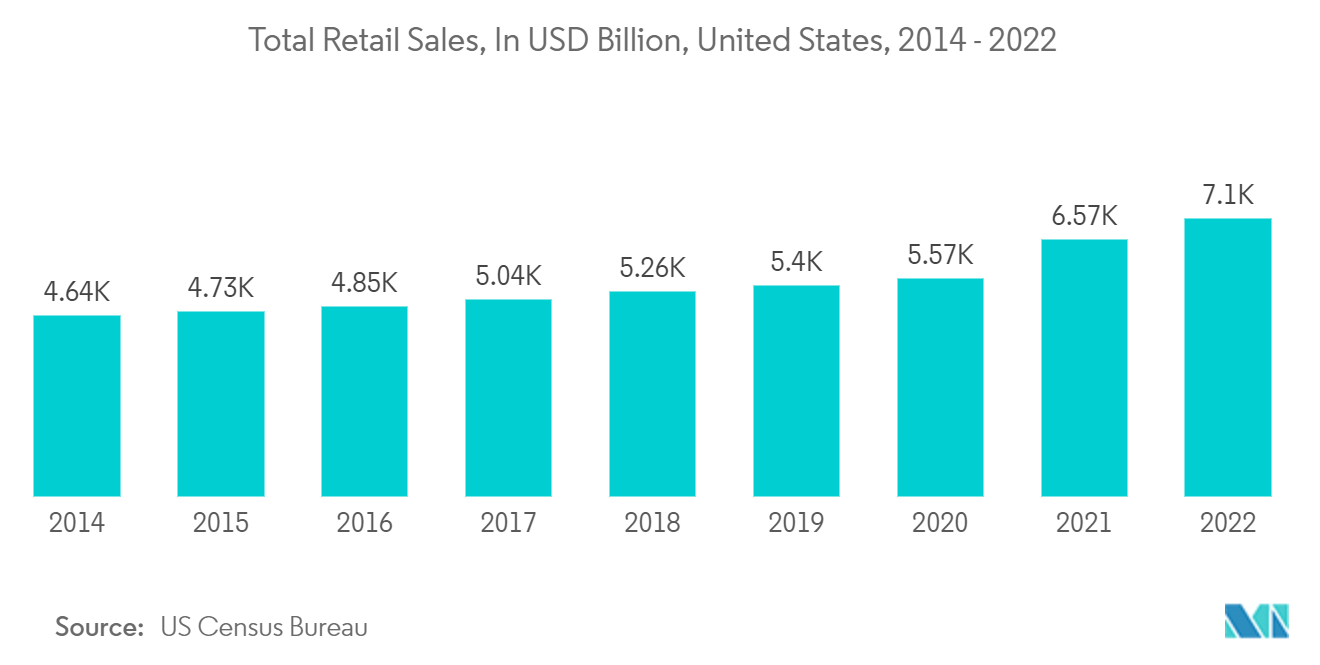
Asia-Pacific is Expected to Register Fastest Growth
- Asia-Pacific is one of the most prominent regions for adopting facial recognition, owing to technological development, rising infrastructure growth, and increasing application in numerous areas. Massive industrialization and the growing consumer electronics industry in the region showcase exciting opportunities for the players in the market and the scope for significant growth.
- Currently, India is one of the largest global destinations in the retail space. In recent years, the retail industry in India has been becoming increasingly more dynamic and fast-paced, owing to the entry of many new players. The industry accounts for over 10% of the country's gross domestic product (GDP) and about 8% of the employment (as per IBEF). Thus, the expanding retail sector in the region offers considerable growth opportunities for the market.
- Further, in August 2022, Hyderabad International Airport announced using facial recognition to enable seamless and hassle-free travel. In line with the DigiYatra program, the Hyderabad International Airport rolled out the digital processing of passengers as a proof of concept through the DigiYatra platform.
- China has used facial recognition technology for a long time. Moreover, the country has deployed facial recognition glasses for the country's police force to spot citizens and tourists and use real-time ID authentication to primarily fight crimes during celebrations.
- The country is also embracing facial authenticated payments. Alipay, China's biggest payment app, started a trial for the smile-to-pay feature at a branch of KFC in Southern China, which uses facial recognition to identify customers and automatically charges them through the app.
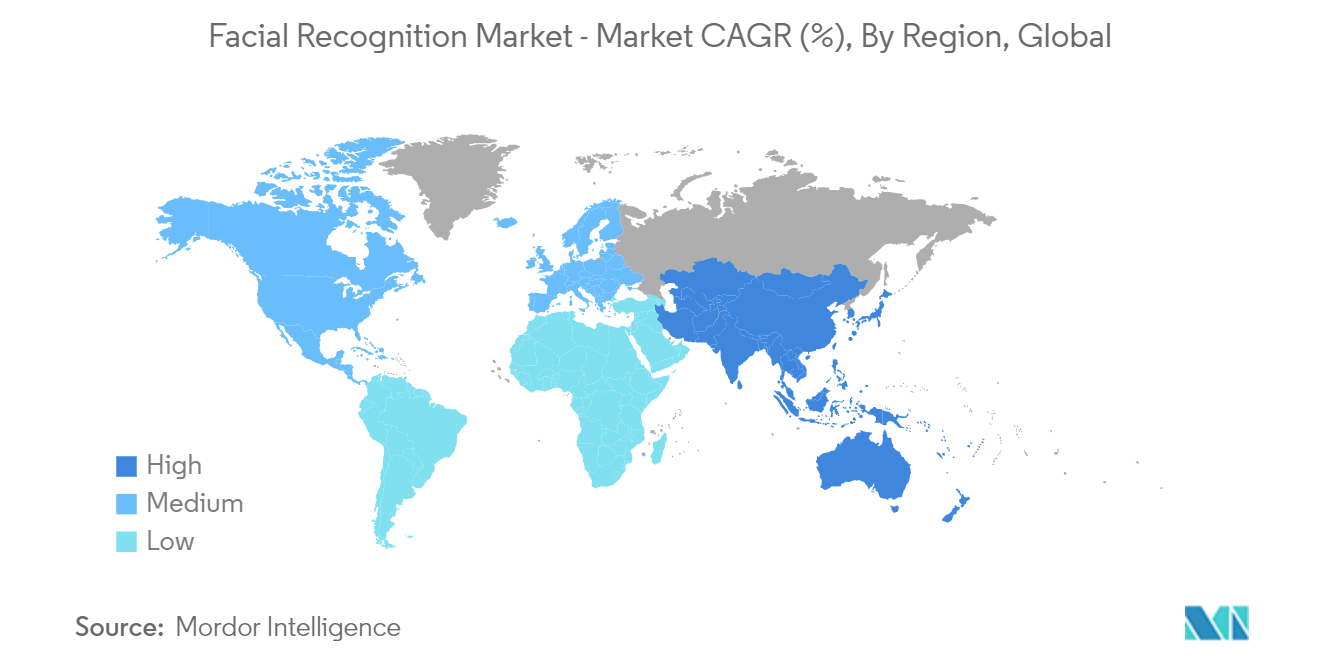
Facial Recognition Industry Overview
The facial recognition market is moderately competitive, with significant players operating in the market, such as NEC Corporation, Gemalto NV, Panasonic Corporation, etc. With the number of startups growing substantially, the market studied is expected to witness a highly competitive scenario shortly.
In June 2023, Hitachi, Ltd. and Panasonic Connect Co., Ltd. collaborated to develop a new service that combines Hitachi's technology for preventing biometric data leakage with Panasonic Connect's facial recognition technology.
In November 2022, NEC Corporation developed a Gateless Access Control System using Biometric Recognition that combines NEC's face recognition technology with person re-identification technology, which matches people even if they are facing away or their bodies are occluded, to provide fast and reliable entry control that is free from gates.
Facial Recognition Market Leaders
-
Panasonic Corporation
-
Thales Group
-
NEC Corporation
-
Cognitec Systems GmbH
-
Aware Inc.
*Disclaimer: Major Players sorted in no particular order
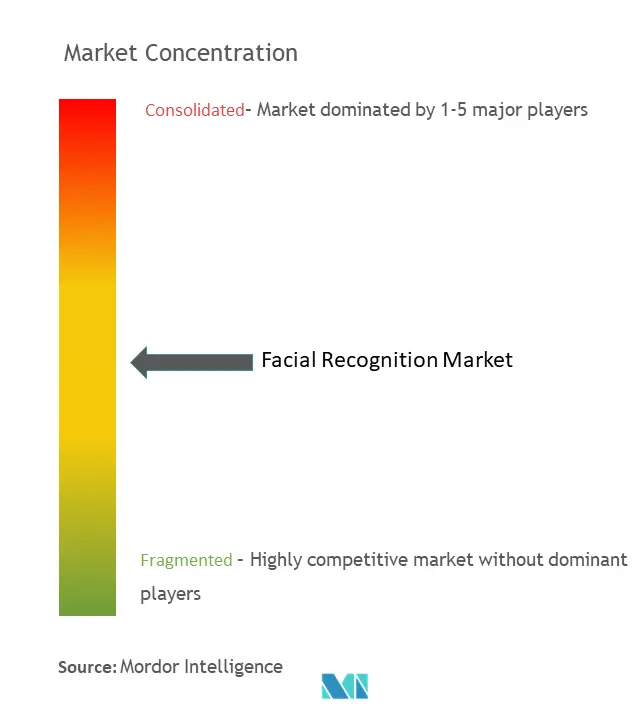
Facial Recognition Market News
- October 2023 - Panasonic Connect Co., Ltd. announced a new facial recognition technology jointly developed by Panasonic Connect, Panasonic R&D Center Singapore (Singapore Research Institute), and NTU Singapore (Nanyang Technological University, Singapore), effectively improving the precision of facial recognition with non-Caucasians and women, which has been an industry-wide issue due to the smaller data sets that have traditionally been available for familiarizing facial recognition models.
- September 2022: CyberLink Corporation, an AI and facial recognition technology, integrated its AI facial recognition engine, FaceMe, into MediaTek’s new AIoT platform, Genio. With the recent MediaTek’s Genio 1200 integration, FaceMe further provides AIoT/IoT developers and system integrators accurate facial recognition capabilities for flexible deployment across various industries, including security, access control, public safety, smart banking, and smart retail.
Facial Recognition Market Report - Table of Contents
1. INTRODUCTION
- 1.1 Study Assumptions and Market Definition
- 1.2 Scope of the Study
2. RESEARCH METHODOLOGY
3. EXECUTIVE SUMMARY
4. MARKET INSIGHTS
- 4.1 Market Overview
-
4.2 Industry Attractiveness - Porter's Five Forces Analysis
- 4.2.1 Bargaining Power of Suppliers
- 4.2.2 Bargaining Power of Buyers
- 4.2.3 Threat of New Entrants
- 4.2.4 Threat of Substitute Products
- 4.2.5 Intensity of Competitive Rivalry
- 4.3 Industry Value Chain Analysis
- 4.4 Assessment of COVID-19 Impact on the Industry
- 4.5 Technology Snapshot
5. MARKET DYNAMICS
-
5.1 Market Drivers
- 5.1.1 Increasing Demand for Surveillance Systems to Enhance Safety and Security
- 5.1.2 Increasing Adoption of Facial Recognition in Consumer Electronics
-
5.2 Market Restraints
- 5.2.1 Privacy Concerns
6. MARKET SEGMENTATION
-
6.1 By Technology
- 6.1.1 3D Facial Recognition
- 6.1.2 2D Facial Recognition
- 6.1.3 Facial Analytics
-
6.2 By Application
- 6.2.1 Access Control
- 6.2.2 Security and Surveillance
- 6.2.3 Other Applications
-
6.3 By End User
- 6.3.1 Security and Law Enforcement
- 6.3.2 Healthcare
- 6.3.3 Retail and E-commerce
- 6.3.4 BFSI
- 6.3.5 Automobile and Transportation
- 6.3.6 Telecom and IT
- 6.3.7 Media and Entertainment
- 6.3.8 Other End Users
-
6.4 By Geography
- 6.4.1 North America
- 6.4.2 Europe
- 6.4.3 Asia-Pacific
- 6.4.4 Latin America
- 6.4.5 Middle East and Africa
7. COMPETITIVE LANDSCAPE
-
7.1 Company Profiles*
- 7.1.1 Panasonic Corporation
- 7.1.2 Thales Group
- 7.1.3 NEC Corporation
- 7.1.4 Cognitec Systems GmbH
- 7.1.5 Aware Inc.
- 7.1.6 FacePhi Biometria SA
- 7.1.7 Animetrics Inc.
- 7.1.8 Ayonix Corporation
- 7.1.9 Face First Inc.
- 7.1.10 Idemia France SAS
- 7.1.11 Daon Inc.
8. INVESTMENT ANALYSIS
9. FUTURE OF THE MARKET
** Subject To AvailablityFacial Recognition Industry Segmentation
Facial recognition is a biometric software capable of uniquely identifying, recognizing, and authenticating a person by comparing and analyzing patterns based on the facial contours of the subject. The report in consideration deals with facial recognition software in line with technologies like 3D, 2D facial recognition, and facial analytics. The study under consideration provides applications, market trends, influencing factors, and growth data of the software by end-users, such as security and law enforcement, healthcare, retail, and other end users.
The facial recognition market is segmented by technology (2d facial recognition, 3d facial recognition, and facial analytics), application (access control, security and surveillance, and other applications), end user (security and law enforcement, healthcare, retail and e-commerce, BFSI, automobile and transportation, telecom and it, media and entertainment, and other end users), and geography (North America, Europe, Asia-Pacific, Latin America, and Middle East and Africa). The market sizes and forecasts are provided in terms of value (USD) for all the above segments.
| By Technology | 3D Facial Recognition |
| 2D Facial Recognition | |
| Facial Analytics | |
| By Application | Access Control |
| Security and Surveillance | |
| Other Applications | |
| By End User | Security and Law Enforcement |
| Healthcare | |
| Retail and E-commerce | |
| BFSI | |
| Automobile and Transportation | |
| Telecom and IT | |
| Media and Entertainment | |
| Other End Users | |
| By Geography | North America |
| Europe | |
| Asia-Pacific | |
| Latin America | |
| Middle East and Africa |
Facial Recognition Market Research Faqs
How big is the Facial Recognition Market?
The Facial Recognition Market size is expected to reach USD 6.61 billion in 2024 and grow at a CAGR of 16.20% to reach USD 14 billion by 2029.
What is the current Facial Recognition Market size?
In 2024, the Facial Recognition Market size is expected to reach USD 6.61 billion.
Who are the key players in Facial Recognition Market?
Panasonic Corporation, Thales Group, NEC Corporation, Cognitec Systems GmbH and Aware Inc. are the major companies operating in the Facial Recognition Market.
Which is the fastest growing region in Facial Recognition Market?
Asia Pacific is estimated to grow at the highest CAGR over the forecast period (2024-2029).
Which region has the biggest share in Facial Recognition Market?
In 2024, the North America accounts for the largest market share in Facial Recognition Market.
What years does this Facial Recognition Market cover, and what was the market size in 2023?
In 2023, the Facial Recognition Market size was estimated at USD 5.54 billion. The report covers the Facial Recognition Market historical market size for years: 2019, 2020, 2021, 2022 and 2023. The report also forecasts the Facial Recognition Market size for years: 2024, 2025, 2026, 2027, 2028 and 2029.
What are the key industries driving the Facial Recognition Market growth?
Key industries driving the growth of the facial Recognition market include security and surveillance, healthcare, retail, and banking, with security and surveillance being the primary driver.
What are the challenges faced the Facial Recognition Market?
Key challenges faced by the Facial Recognition Market include: a) Privacy and ethical concerns b) Need for high-quality data c) Potential for bias in recognition algorithms
Facial Recognition Industry Report
The Global Facial Recognition Market is on a rapid growth trajectory, fueled by escalating security needs and the demand for efficient surveillance across various sectors, including airports, critical infrastructure, and public spaces. This surge is propelled by the adoption of facial recognition technology in mobile devices for enhanced authentication, finding applications in finance, healthcare, education, and retail to streamline operations and secure transactions. Despite facing challenges like privacy issues and the threat of hacking, continuous innovations by top facial recognition companies are paving the way for more secure solutions. The Asia Pacific region is leading the growth, driven by technological advancements and a focus on modernization, especially in government applications to boost public safety. As the market expands, highlighted by Mordor Intelligence™ Industry Reports, which offer a comprehensive analysis and forecast, it's imperative to ensure the ethical use of this technology by balancing its benefits with privacy safeguards. Get insights into the market's size, share, and revenue growth, along with a historical overview, by downloading a free report PDF sample.



